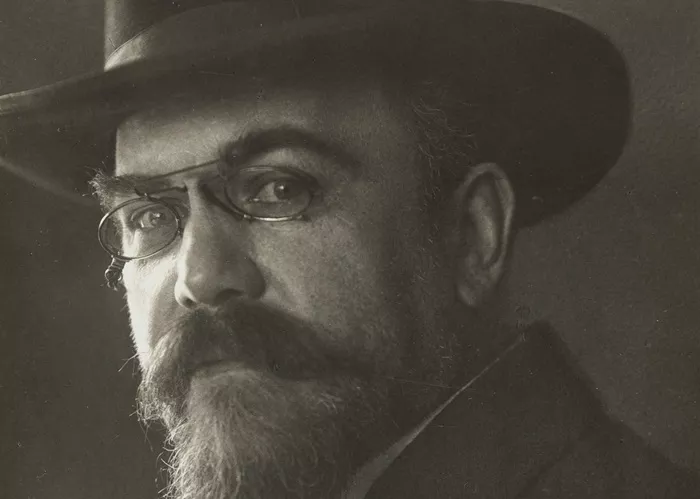The 19th century was a transformative period for German poetry. It was marked by the flourishing of Romanticism, the rise of Realism, and the growing influence of political and philosophical thought in literature. Among the poets of this period, Hanns von Gumppenberg (1866–1928) remains a lesser-known but significant figure. His works reflect the literary tendencies of the time, drawing inspiration from both Romantic and modernist traditions. Although not as widely recognized as contemporaries like Heinrich Heine or Eduard Mörike, Gumppenberg contributed uniquely to German poetry. This article explores his literary contributions, comparing his work with other poets of the era and examining his place in the broader context of 19th-century German poetry.
Hanns von Gumppenberg
Hanns von Gumppenberg was born in 1866 in Bavaria, a region deeply embedded in the cultural and historical framework of Germany. His aristocratic background provided him with an education that exposed him to classical literature, philosophy, and the arts. Unlike some of his contemporaries who pursued political or journalistic careers, Gumppenberg devoted himself to poetry and literature. His works, although not as prolific as some of the major poets of the 19th century, showcased a deep sensitivity to nature, emotion, and philosophical musings.
The Literary Landscape of 19th-Century German Poetry
German poetry in the 19th century was shaped by the dominance of Romanticism in its early decades and the emergence of Realism and Symbolism later on. Romantic poets such as Novalis, Friedrich Hölderlin, and Joseph von Eichendorff emphasized emotion, nature, and the individual’s inner world. However, as the century progressed, poets like Theodor Storm and Conrad Ferdinand Meyer introduced more grounded, realistic themes into their work. By the late 19th century, influences from Symbolism and early Modernism began to emerge.
Hanns von Gumppenberg’s poetry fits within this transition. His works exhibit the introspective and idealistic tendencies of Romanticism, while also hinting at a more modern understanding of poetic form and expression. This blend of styles makes his work unique among 19th-century German poets.
Hanns von Gumppenberg’s Poetic Style and Themes
Gumppenberg’s poetry is characterized by its musicality, imagery, and philosophical depth. Some of the recurring themes in his work include:
Nature and Landscape: Like the Romantics, Gumppenberg often depicted nature as a source of beauty and contemplation. His verses capture the changing seasons, the solitude of forests, and the mystery of the night sky.
Emotion and Subjectivity: His poetry explores human emotions, love, and existential longing, reflecting the Romantic ideal of personal introspection.
Symbolism and Abstraction: Unlike earlier Romantics who focused on vivid storytelling, Gumppenberg incorporated symbolic elements into his poetry. This approach aligns with the later Symbolist movement, which sought to convey deeper meanings through abstract imagery.
Philosophical Inquiry: His works also contain reflections on life, death, and the human condition. These themes align with the existential questions that gained prominence in late 19th-century German literature.
Comparison with Contemporaries
To understand the significance of Hanns von Gumppenberg’s contributions to German poetry, it is essential to compare him with other poets of the time.
Heinrich Heine (1797–1856): Heine was one of the most influential German poets of the 19th century. His sharp wit and political engagement contrast with Gumppenberg’s more introspective and lyrical approach. While Heine’s poetry often criticized society and politics, Gumppenberg’s verses remained largely personal and philosophical.
Eduard Mörike (1804–1875): Mörike’s poetry, like Gumppenberg’s, was deeply lyrical and centered on nature. However, Mörike’s language was simpler and more direct, while Gumppenberg embraced a more symbolic and abstract style.
Stefan George (1868–1933): George, a contemporary of Gumppenberg, was part of the Symbolist movement in Germany. His poetry was highly stylized and aimed at a refined aesthetic experience. Gumppenberg, though influenced by similar trends, maintained a more organic and emotional tone.
The Influence and Legacy of Hanns von Gumppenberg
Although Hanns von Gumppenberg never achieved the widespread recognition of poets like Goethe or Rilke, his work remains an important part of German literary history. His poetry serves as a bridge between Romanticism and the emerging modernist tendencies of the late 19th and early 20th centuries. Scholars of German poetry appreciate his contributions for their stylistic innovations and their introspective depth.
Gumppenberg’s legacy is also reflected in the continued interest in lesser-known poets of the 19th century. His works, though not as frequently studied, offer valuable insight into the evolving landscape of German poetry during this period. His ability to blend traditional Romantic themes with emerging Symbolist elements highlights his role as a poet who navigated the shifting literary currents of his time.
Conclusion
Hanns von Gumppenberg remains a fascinating figure in 19th-century German poetry. His work encapsulates the transition from Romantic idealism to a more abstract and philosophical poetic style. While he may not have gained the fame of some of his contemporaries, his poetry contributes to the richness of German literary tradition. By examining his work in the context of other 19th-century German poets, we gain a deeper understanding of the diversity and evolution of German poetry during this significant literary period. As interest in historical literary figures continues to grow, Gumppenberg’s poetry may yet receive the recognition it deserves.

